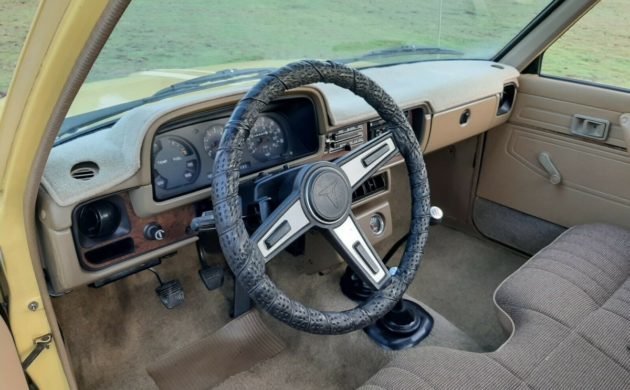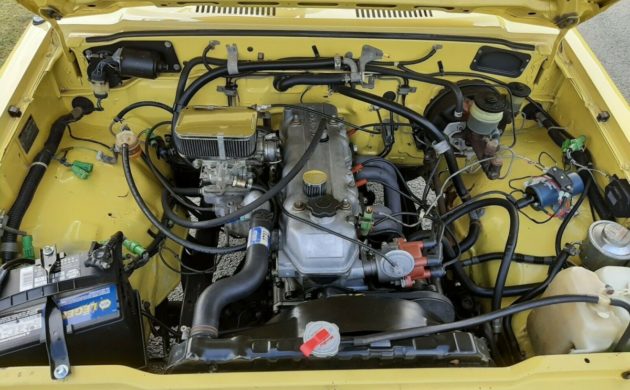This 1979 Toyota SR5 pickup is an impressive original-paint survivor with 115,000 miles on the clock. That’s not exactly low by collector car standards, which makes its condition all the more impressive. The Toyota is configured just the way enthusiasts like, with four-wheel drive and the short bed, along with the SR5 package. The seller notes that the truck is in incredibly clean condition, from the interior carpets to the numbers matching 20R engine. Unlike so many Japanese vehicles from this era, there’s not a speck of rust to be found. You can find it listed here on eBay where bidding is up to $12,900 with no reserve.
The seller notes he is the second owner, having purchased the Toyota from the longtime original owner. The truck has been garaged while in the care of both owners, and the underlying condition suggests it hasn’t been exposed to the salt that removed many of these import pickups from the roads in the snow belt states years ago. The seller’s location is Washington State, and it wouldn’t surprise me if this Toyota has lived in the Pacific Northwest since new. There’s a tremendous following for vintage Toyotas in the PNW, and they survive at an impressively high rate. The Toyota rides on new tires with sharp polished wagon wheels.
Ironically, I just snagged one of these steering wheels out of Germany for my 1981 Toyota HiAce project, not realizing that it came as an option in the U.S.-market pickups. Oh well – it may have proved challenging to find a brown one like I needed. The cabin is in outstanding condition, again defying the six-digits on the odometer, with carpets and seating surfaces showing little to no signs of significant wear. The door panels also look quite clean, and the same goes for the dash which wears a carpeted mat that matches the interior colors. The steering wheel wrap isn’t attractive, but it has hopefully protected the original surface underneath.
The venerable 20R engine is said to run well and has been enhanced with a few key upgrades. These include a Weber carburetor, K&N air filter, Offenhauser aluminum intake, thick flange header, and electronic fuel pump. Other maintenance-driven improvements include a new exhaust system, muffler, battery, radiator, alternator, belts, and more. The engine bay paint matches perfectly with the exterior, supporting the claim that the truck hasn’t been left sitting outside for extended periods of time. This is a classic you can either drive like any other vehicle or preserve for the long-term, which is why they remain so popular today.






These trucks were mainly 2 wheel drive vehicles in Africa and were classed as one tonners, but most of them regularly carried 2 tons or more, and were found to be virtually indestructible. Check out the Top Gear episode where Clarkson and Co. resort in the end to placing it on the top of a 4 or 5 story building and then demolishing the building! Once the dust had settled they started it up and drove it away! If you view reruns you will often see it as a backdrop to whatever is going on.
“placing it on the top of a 4 or 5 story building…” plus leaving it on the beach at low tide, setting it on fire and hitting it broadside with a wrecking ball … but, of course — it was a diesel!
Those carpeted dash covers always remind me of a local rapper named Sir Cracks A lot.
Man, I love yellow Toyotas.
Worked at a Toyota dealer in 1979. Interesting year to start a new job. Everybody loved the new body style of the new Toyota pickup. Toyota would ship their trucks over with no beds and then have the beds install at the port in Long Beach , California. Not sure of the company that got that contract. Over time the bed paint would change it’s shade a little different from the cab. Spot welds could be seen alone the rear wheel wells as Toyota didn’t car about the looks so much. Then one day the Toyota Supra came out. What a year in 79′
Working and going to school while driving a 74 Datsun 620, I put 500.00 down and my name on a list to get one of these great little trucks when they first came out. Next thing I know I’m cancelling my reservation and paying my lawyer that 500.00 to save my butt for some extra-curricular activities. Money well spent in the end, but I have never forgiven myself for missing out on a game-changer like this truck.
That’s not a 1979 SR5, because there was no such thing as an SR5 option in 1979. While the VIN confirms a May of 1979 build date, that gauge cluster and pod were not available until the 1980 model year. Speaking of cancelled orders, I cancelled my order for a Subaru Brat in late 1978 when I heard these were coming out, and couldn’t have been happier with my 79 – one of the first on the East Coast in 10/78. When the SR5 package came out in 1980, I was a little disappointed not having the gauges and stripe package, so found a wrecked ’81 in California and swapped the cluster and gauge pod. Exactly what this seller has done, but not advertised